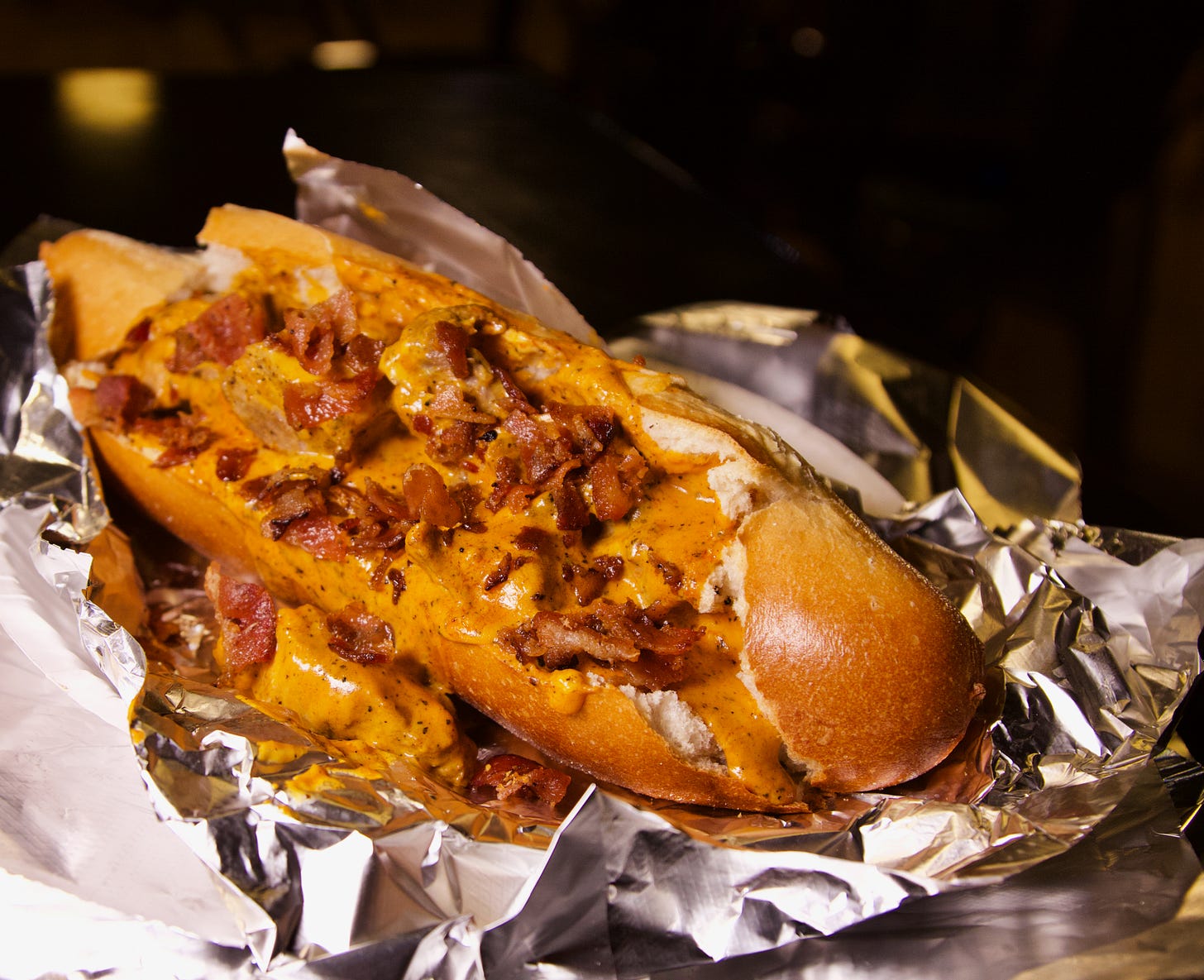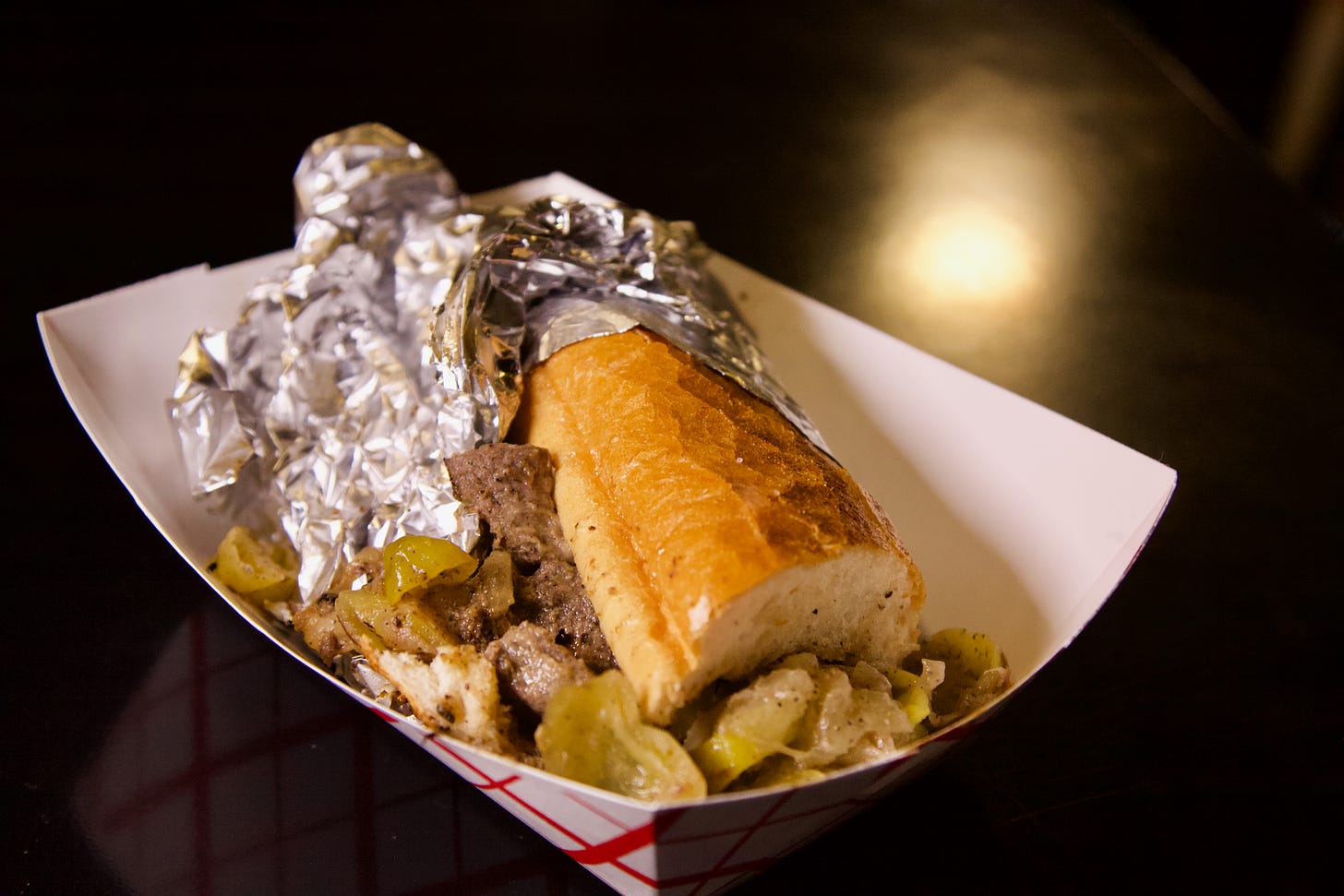Spiedie overhaul 🍽
After rapidly rebranding his ramen shop, Chef Mark Henry has faced an uphill battle in educating consumers about his hometown's beloved sandwich. But the concept's starting to gain a foothold.
After my recent visits to Kelley’s Spiedies — which replaced Rooster’s House of Ramen in early March, 2023 — I thought back to something chef/owner Mark Henry told me at that time. He described the spiedie sandwich as blue collar food. He painted me a picture of an average guy getting off work in Henry’s hometown of Binghamton, New York. Say, from HVAC labor: arriving home tired, heading out to the front porch with a cooler of cheap beers (like Genesee) and hauling along bread rolls to hold grilled meat cubes meat likely prepared the weekend prior.
Dinner. No frills. Mostly utility. Perfect in its humble simplicity.
The reason I thought back to this is on the days between my visits to Kelley’s I spent a dozen hours on the roof of my greenhouse/sunroom patching leaks from the recent rains. Balancing on boards, ascending and descending ladders, scraping off old sticky substances only to reapply new ones, taping skylight mounts, caulking crevasses, sweating, cussing, complaining about my sore low back, and of course, enjoying the camaraderie born out of a generous mate suffering with me the whole way.
Which is to say I believe I inadvertently role played, walking in the shoes of Henry’s sample worker. That gave me fresh perspective on appreciating the spiedie for how it came to be and how it has culturally evolved. Filling food you want to eat when you’re dead tired and have no energy for complex cookery. Since its popularity rise several decades ago, the spiedie has earned its way onto top sandwich-style lists and even spawned an annual festival.
Henry described the spiedie as “the cornerstone of county fair style events” and it’s easy to imagine them at backyard barbecues and church potlucks and such. Which might make one wonder how the sandwich plays in a sit-down restaurant setting in downtown Colorado Springs. One that happens to be attached to a shapeshifting speakeasy (Allusion), at that.

The answer: it’s more complicated than the sandwich. It’s an eclectic mishmash atmosphere wise. We eat in a starkly appointed dining room with an exposed industrial ceiling and open kitchen with a fluorescent glow backlighting digital menus and spirit bottles behind the order counter. There’s walls painted in red and white picnic table checkerboard print that playfully contrast the moody urban vibe. Out of context: It’s like the spawn of a daycare and a dive bar. Then some people dressed as wizards walk by. (Because Allusion’s theme is Harry Potter at present.)
I find it fair in a critical context that a newcomer might question what the place is aiming for and how all the incongruent visual aspects add up into a coherent story. “Where are we? What is going on? What’s this place trying to be?” (Once you know, then imagine someone over in Allusion in a cloak with a lamb spiedie in one hand and a $14 fancy cocktail in the other. Odd sight perhaps.)
“We were wondering if we made a mistake in the first couple of weeks,” says Henry, regarding the transition from Rooster’s (which you can read my full back story on here). But, these two months later, “the numbers are improving and we’re getting great feedback and reviews,” he says.

To give some grace on the hodgepodge nature of it all, it helps to know that there’s a very sincere tribute to Henry’s mom Kelley that underpins the shop’s intentions. And Henry’s also paying tribute to his roots in a way that he authentically can as a native son. The overhaul of the space to go from ramen bowls to grilled sandwiches took place inside one hectic week. Henry’s family and crew worked brutal hours to bring it all together.
Allusion existed prior and has always had that odd pop-up nature to it — a thing in a back of another thing that’s like a secret but not really because it’s sold out all the time. If it’s not wizards now, it’ll be stormtroopers and Jedi knights later or girls in Alice In Wonderland-style dresses sauntering through the dining room. (Recent theme examples.)
I say: just roll with it. Henry and his crew have. By way of lessons learned, he tells me the main drawback to the rapid rebranding was he missed the opportunity to properly market and educate the public about spiedies and their culture. Try as he did on social media. He eventually posted on CoS Foodies and our Culinary Colorado Springs Facebook groups to essentially ask the community what their hesitation was for trying his new concept out. Among honest feedback, some folks explained a common conundrum: they have picky eaters in their family who require certain dishes in order to commit to going out to eat. So if there’s no chicken tenders for the kids or a burger for boring-ass Americans it’s often a no-go.
So Henry, who’s softened from his early days back at Blue Star and The Meat Locker (when he was less inclined to do anything other than what he envisioned, and wasn’t shy of saying “no” with an f-bomb in front of it) took the feedback to heart. He added a spiedie-inspired burger that he’d created on the TV show Cooks vs. Cons, which he appeared on (and won) in 2016.
His staff noticed that many folks were adding cheese to their spiedies (which is an option for $1 with online and in-store ordering), so Henry and his team decided to create new, fusion-style spiedies that get a little saucier and cheesier. That’s compared to the classic, authentic spiedies like the lamb or chicken, which simply get the house meat marinade (a recipe Henry protects) and are served solo on the Philly-style Amoroso rolls.
Chef de Cuisine Evan Neece, who’s cooked around town with Henry for more than a decade, including at Blue Star, Street Eats and Rooster’s, tells me that in Kelley’s early days many would-be customers would walk out once they realized that Rooster’s wasn’t existent anymore. But others would give a shrug and stay to give the spiedies a try. And many have turned into repeat customers he says. Henry jokes about it: “We got more support for Rooster’s after it closed than when it was open. These supposed die-hard fans would say ‘that was my favorite place’ and when I’d ask what their favorite ramen was, they’d say ‘that pork bowl’ — which hadn’t been on my menu for two years. So yeah, it was clearly your favorite place.”

When I ask Henry about the aforementioned incongruent elements, he says that the new format has “opened doors for us to be creative and have more freedom to play.” He’s happy to be educating consumers on a new-to-them product. And he’s glad to be educating his team on butchery, as they break down all the meats in house and the kitchen crew has responded favorably to the learned skills.
On that note, Henry’s added vegan items too, like a portobello mushroom spiedie and banana pancakes on the breakfast menu, another departure from the early, strict, traditional spiedie plan. I didn’t go in for breakfast, which also includes quiche and buttermilk biscuits. There’s also side items like baked beans, mac n’ cheese, pasta and potato salads, plus desserts like pies and a chocolate peanut butter cup. Kelley’s also acts as a commissary kitchen for Rocky Mountain Pretzel Co., so those are also available with mustard or a cheese dip.
So, clearly, there’s much more afoot than just spiedies at Kelley’s.
Before we conclude a phone chat after my second visit (Henry wasn’t on site either time I stopped by), I ask Henry how he’s now feeling about the whole transition, with a couple of months behind him in the rearview mirror. He says “I can breath now.” He sounds optimistic and hopeful. He says he was at the shop early that morning to do computer work, and just before opening, the ticket machine spit out three back-to-back to-go orders for 9:15 (current hours are 9 a.m. to 9 p.m.). That’s the sound of progress. Of Kelley’s catching on.



Very descriptive and extremely well written